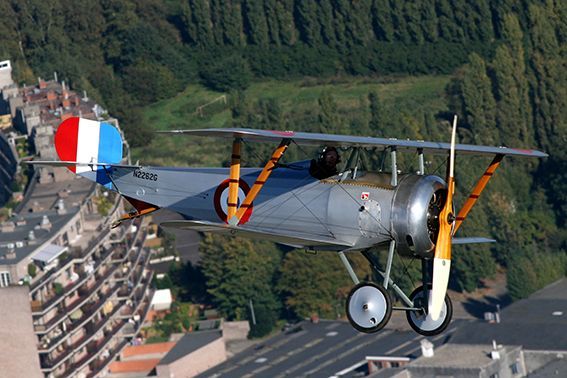
Nieuport 24
This French biplane is a replica built by Carl Swanson (USA) and is not equipped with an original Le Rhône engine, but with an 85 hp Gnome-Rhône rotary engine.
Our Nieuport 24 is painted in the colors of the French Armée de l'Air during the First World War.
A successor to the Nieuport 17
The Nieuport 24 was a much improved version of the Nieuport 17 developed on the eve of the Great War (14-18). This model 17 was therefore the aircraft of choice used by the French top aces and with which they achieved the majority of their victories at the beginning of the war.
The Nieuport 24 had an improved fuselage fitted with extra tension cables to reduce drag. Also, the wing flaps were rounded to greatly improve the manoeuvrability of this fighter. The wing section and new tail were made of plywood to achieve a tighter construction that could rival the closest competitor: the SPAD VII.
After the Nieuport 24, the model 27 entered service, which was in fact a slightly different model 24. It became the last Nieuport with the well-known "V" wing styles. A derivative of the Nieuport 24 became the 24bis, which entered production when the delivery of tailpieces for the 24 failed to follow.
The Great War
When the Nieuport 24 appeared on the battlefield of the Great War, the model was in fact already outdated. However, in the hands of skilled fighter pilots it was a formidable opponent for the Germans. The climbing ability of the Nieuport 24 was by far the best at the time, until the arrival in 1918 of Fokker D.VII in the German camp.
From the spring of 1917 the Nieuport 24 was used in large numbers as a fighter by the French until the spring of 1918 when it was replaced.
The training squadrons used the model 24 until the end of the war.
Most French, Belgian and American fighter pilots in training flew several hours with the Nieuport 24 during the First World War.
The task of the Nieuport 24 was mainly to escort army convoys on the battlefield and to maintain local air superiority in their sector.
For this reason, they were divided into Battle Groups (Groupes de Combat – GC), each of which was divided into different Wings, which in turn consisted of squadrons, which controlled a particular sector of the front. For example, the Nieuports 24 were assigned to the GC11 to GC15 of the French Armée de l'Air.
From 1917 the Nieuport 24 was gradually withdrawn from the GCs and replaced by the SPADs.
However, the model 24 continued to be used on the Russian front and continued to be used in the Russian states after the First World War (1920).
Stampe en Vertongen Museum vzw
Antwerp International Airport
Bus 3
B-2100 Antwerp-Deurne
Belgium
O.N. BE0447.236.613
RPR Antwerp
email: stampe@skynet.be
www.stampe.be
Opening hours individual visits
- Mon - Fri
- Closed
- Sat - Sun
- -
Closed on Easter Sunday and during August, December and January
Useful links
All rights reserved | Stampe en Vertongen Museum vzw






